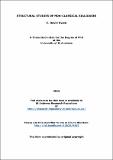Structural studies of non-classical sialidases
Abstract
Streptococcus pneumoniae is a common resident of the human nasorpharynx that
can cause severe illness, including bacterial meningitis and pneumonia. Ruminococcus
gnavus is a commensal resident of the human gastrointestinal tract, present in the vast
majority and overrepresented in those with inflammatory bowel disease. Both bacteria
exploit very different niches, however both make use of sialidases, a class of enzymes
that releases terminal sialic acids from sialoglycoconjugates by hydrolysing the α-glycosidic linkage. There are three pneumococcal sialidases: SpNanA, a hydrolytic
sialdiase; SpNanB, an intra-molecular trans-sialidase; and SpNanC. The primary reaction
product of SpNanC is Neu5Ac2en (2-deoxy-2,3-didehydro-N-acetylneuraminic
acid, also known as DANA), a potent inhibitor of hydrolytic bacterial and viral sialidases.
The crystal structure of SpNanC in complex with Neu5Ac2en has been solved
and a reaction mechanism for its formation proposed. R. gnavus can grow on sialylated
substrates however it does not grow on sialic acid. The crystal structure of
RgNanH has also been solved, confirming that it is an intra-molecular trans-sialidase,
like SpNanB, that produces 2,7-anhydro-Neu5Ac, a sialic acid derivative with an intra-molecular linkage. This suggests a method of partitioning an important carbon
source in a competitive environment. These works highlight the importance of thorough
structural characterisation of sialidases, because although they may appear
superficially very similar, they have significant diversity in their reaction mechanisms
and their responses to inhibitors.
Type
Thesis, PhD Doctor of Philosophy
Collections
Items in the St Andrews Research Repository are protected by copyright, with all rights reserved, unless otherwise indicated.

